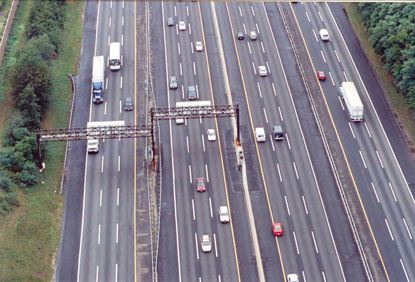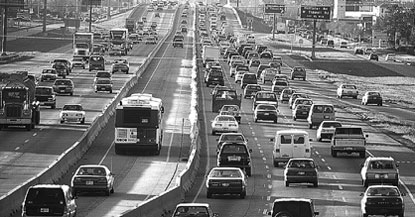|
|
|
MANAGED LANES: A Cross-Cutting Study
Chapter Two. Managed Lanes: State of the Practice
Traditional Lane Management Strategies
State departments of transportation (DOTs) have for many years employed a variety of lane management strategies in an effort to address congestion in urban areas. The earliest of these strategies is the use of controlled access facilities to concentrate ingress and egress points and minimize the effects of weaving and slowing vehicles. Over the years the menu of lane management strategies has grown to encompass a wide range of tools and techniques for maximizing the efficiency of the network. Exhibit 2 lists a variety of lane management strategies in use by transportation agencies. Typically, lane management strategies seek to optimize flow by:
- Regulating demand,
- Separating traffic streams to reduce turbulence, and
- Utilizing available and unused capacity.
Two common approaches to lane management are restricted use based on vehicle eligibility, and control of access through limited ingress/egress express lanes and ramp metering. Examples of managed lane facilities that represent the state of the practice include high-occupancy vehicle (HOV) lanes and exclusive or special use lanes (3).
| Lane Management Strategies | |||
|---|---|---|---|
| Management Strategy | Management Characteristics | Management Techniques in Operation | |
ELIGIBILITY Eligibility refers to management based on vehicle type or user group. |
Occupancy | Lanes based on occupancy provide a priority to HOVs. Typically implemented in congested corridors to encourage shift to HOVs. Designed to provide travel time advantage and trip reliability. | California, Texas, Washington, Virginia, Minnesota, Colorado, Pennsylvania. Arizona, Florida, Connecticut, Georgia, Maryland, New York, New Jersey, Oregon, Tennessee, Hawaii |
| Vehicle | Management based on vehicle type. May provide a superior service as in the case of transit-only facilities. May seek to improve operations by separating vehicles types. |
|
|
ACCESS CONTROL Limited or controlled access allows management of the flow and throughput of traffic on a facility. |
Express Lanes | Express lanes have limited access and egress points thereby reducing weaving and disruptions in traffic flow |
|
| Ramp Meters | Meters control the flow of traffic onto a facility to reduce turbulence, resulting in smoother flow. |
|
|
HOV LANES
High Occupancy Vehicle (HOV) lanes, as shown in Exhibit 3, are some of the earliest lane management strategies that provide priority for certain vehicle types. Preferential treatment for transit began in Northern Virginia on I-395 with the bus-only lane in the 1960s. Since then over 2,000 centerline miles of HOV lanes have been developed around the country. HOV is by far the most common managed lane strategy. Most HOV lanes have the common goals of increasing person-movement within a facility by increasing vehicle occupancy, improving transit operations, and providing an attractive mobility choice for travelers in the corridor (4). HOV facilities use vehicle eligibility as the primary mechanism for regulating demand and achieving optimum operating conditions.
EXCLUSIVE OR SPECIAL USE LANES
This strategy is used to provide an exclusive lane to certain vehicle classifications (Exhibit 4). Most often this is dedicated to buses or large trucks (3). Exclusive bus-only lanes act to provide an incentive to transit riders. By providing a special lane for the exclusive use of buses, these vehicles achieve a travel time advantage as opposed to vehicles in the general-purpose lanes.

Exhibit 4. Dual-Dual Roadway (6)
Truck lanes operate in much the same fashion as bus-only lanes. However, the objective is different. The goal in separating truck traffic from passenger traffic is to improve the flow of a facility and provide an increased level of safety by reducing possible conflicts between large trucks and other vehicles. Separate truck lanes may be feasible in areas where truck volumes exceed 30 percent of vehicular traffic, peak-hour volumes exceed 1800 vehicles per lane-hour, and off-peak volumes exceed 1200 vehicles per lane-hour (3). Exclusive lanes use vehicle eligibility to achieve operational objectives.
Previous | Table of Contents | Next
